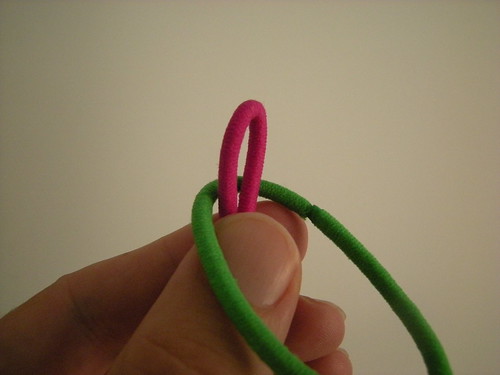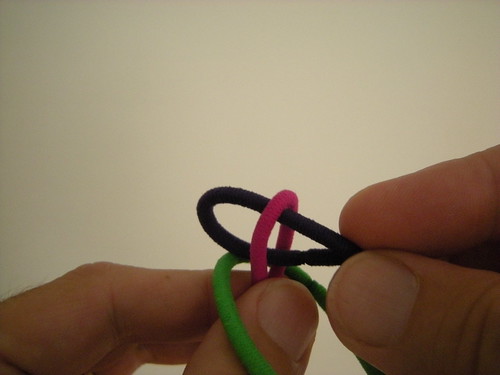 |
| Making an o-knitting vertex, Step 1: Hold Needle upright. |
 |
| Toss Quoit on Needle. |
 |
| Feed Thread through Needle. |
 |
| Pull Quoit through Thread. |
 |
| Voila! a completed vertex. |
 |
| Close-up of completed o-knitting vertex. |
All sorts of things that I'll call
o's are available to the craftsperson: rubber bands, ponytail holders, potholder loops, etc. O's can also be made at home by slicing across a can or plastic bottle, or anything else of tubular cross-section. O's can be knit together to form 3D shapes without the increases and decreases traditionally depended upon in knitting and crochet. O-knitting can optionally be guided by a string of letters drawn from a four-letter alphabet, what I call an
undip word, that describes the step-by-step construction of a surface. Using undip words, o-knitting becomes a sort of genetic knitting.
There are only two big things to learn about o-knitting: how to make a vertex, and how to follow an undip code. Learn those two things and you will be a able to build a spaceship on a desert island, or at least a floppy grass model of one.
An o-knitting vertex is an inter-looped union of three o's. An o-knitting vertex is a
reciprocal structure. That is, each of the o's plays the same role in the union. We'll give each o a name according to how it first enters the union, but by the time we are done making the vertex they'll all be equivalent. An o-knitting vertex is a three-way version of Mrs. Bright's (four-way) True Lovers' Knot (
Ashley Book of Knots #2425.)
OK, let's make an o-knitting vertex. The first o is called Needle. Except at the very first vertex (call it the origin,) Needle will already be attached to the work. Hold Needle with its free end upward.
The second o is called Quoit. Quoit is always free at both ends. Toss Quoit over Needle.
The third o is called Thread. Feed Thread through Needle. It is best to always feed Thread from the right side (or always from the left side, if you prefer.) Feeding from the same side makes vertices that are all of the same handedness, giving the fabric a more even look. Thread will be free at both ends when making u and n vertices, but already in the work when making p and d vertices.
Now feed Quoit through Thread (i.e., through the end of Thread that pushed out through Needle.)
Voila! One vertex made. 3D shapes are made by repeating the above moves.
3-D shapes may be specified by an undip word or genotype, a character string made up of the four emoticons: u, n, d, and p.
For example, a genotype for the cube is
nuupdd .
The the letters are called emoticons because they are meant to be read with the head tilting sideways (toward the right) and their meanings are visually obvious—no need to wake up the left side of the brain at all. The four o-knitting actions they encode are:
"Open left," meaning: "make a new vertex and leave the o on the left side dangling," (i.e., continue to the right. )
"Open right," meaning: "make a new vertex and leave the o on the right side dangling," (i.e., continue to the left.)
"Close left," meaning: "make a new vertex employing the nearest dangling o on the left side."
"Close right," meaning: "make a new vertex employing the nearest dangling o on the right side."
(Figure out for yourself which emoticon encodes which action.)
Note that at a close vertex the roles of Needle and Thread can be assigned so that Thread enters Needle consistently from the right (or, alternatively, consistently from the left.) A switch causes no confusion about how to continue, since just a single o is left dangling after a close vertex.
You have to work consistently from the outside of the piece (or consistently from the inside.) Early on this will mean taking care that o's do not get twisted. At the end, should you find you have made the enantiomorph of what you intended—no problem. Just evert the piece through one of its openings.
Quoit must always be free at both ends, but at the final vertex all three o's will already be attached to the work. The final vertex must be joined by some other technique. The simplest way is to add a fourth o as Quoit, making the last vertex a regular fourway Mrs. Bright's knot. The extra o is left dangling, permanently marking the origin (and terminus) of the undip word.
Hansel & Gretel's Hint: mark your very first o with a twist tie or special color—should you get lost, you can can retrace the word from the beginning.











